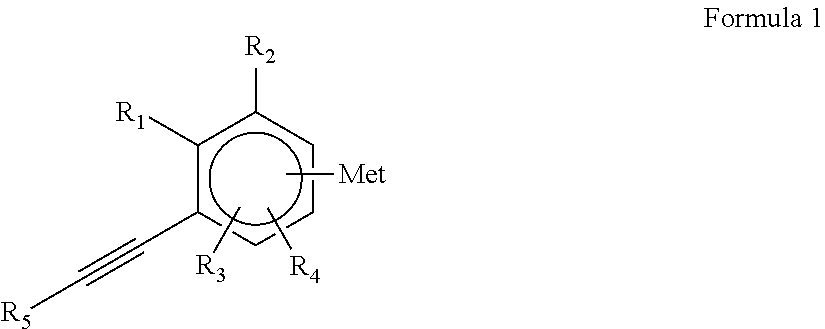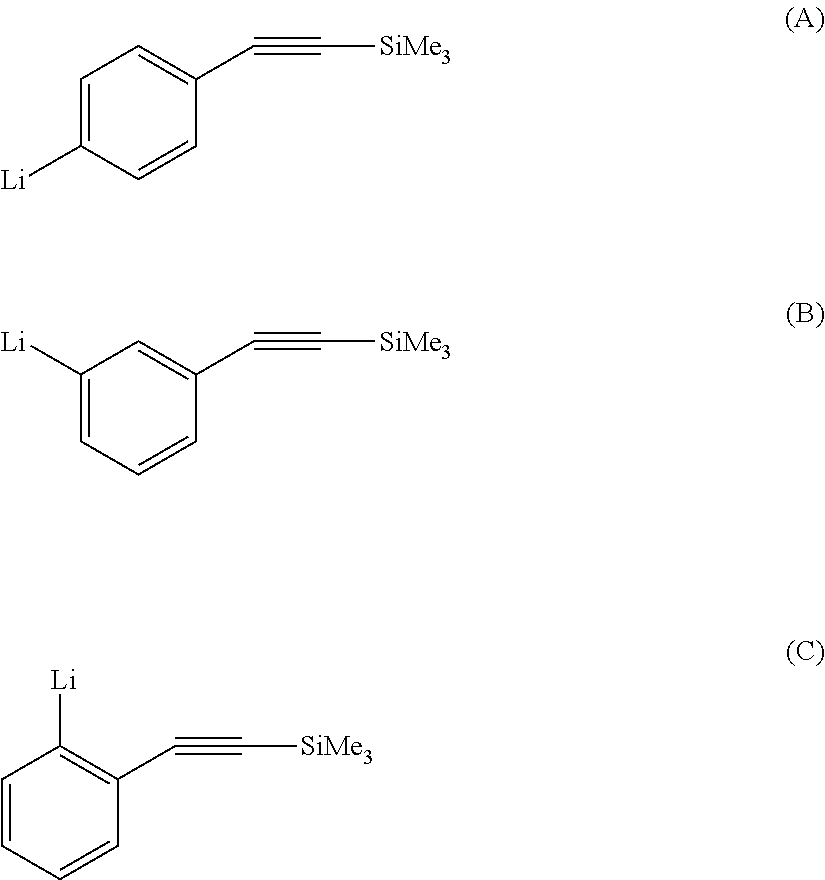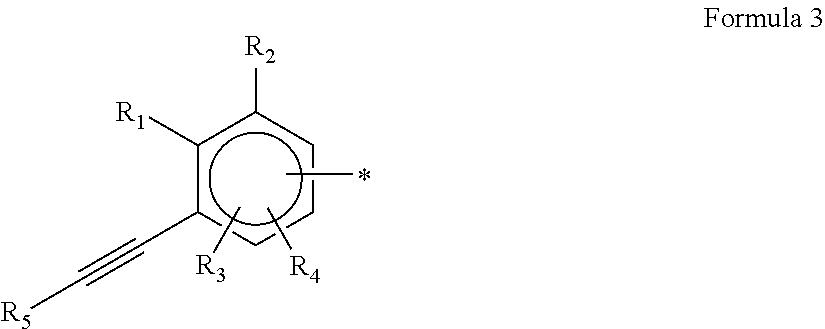Diene copolymer including at least two blocks, method for synthesizing same and rubber composition containing same
a diene copolymer and diene technology, applied in the field of diene copolymer synthesis process comprising at least two blocks, can solve the problems of difficult difficulty in synthesis of block diene copolymers, and difficulty in achieving the effect of high yield
- Summary
- Abstract
- Description
- Claims
- Application Information
AI Technical Summary
Benefits of technology
Problems solved by technology
Method used
Image
Examples
example 1
Synthesis of Protected Acetylene-Functional Polybutadiene According to the Invention
[0163]
[0164]A / Synthesis of the initiator:
[0165]The protected acetylene-functional initiator is prepared by dissolution of 1.9 g (7.5×10−3 mol) of 1-bromo-4-(trimethylsilylethynyl)phenyle in 65 ml of methylcyclohexane at ambient temperature under nitrogen, followed by the addition of 0.11 ml of tetramethylethylenediamine and 11.7 ml (15×10−3 mol) of a 1.28 mol / l s-BuLi solution. The halogen / lithium exchange reaction is left stirring at ambient temperature for 45 minutes and then the initiator solution is assayed by Gilman-type assaying. The concentration of active entity is 0.114 mol / l.
[0166]B / Synthesis of the protected acetylene-functional polybutadiene:
[0167]Anionic polymerization is carried out in a capped bottle with moderate stirring and under an inert nitrogen atmosphere. Before beginning the polymerization, 94 ml of methylcyclohexane are introduced into the bottle. The bottle is capped and spar...
example 2
Synthesis of Acetylene-Functional Polybutadiene from the Protected Acetylene-Functional Polybutadiene
[0171]
[0172]2 g of polybutadiene (Mn=54 000 g / mol and PI=1.11) are dissolved in 12 ml of THF. 0.37 ml (0.37 mmol) of a 1M solution of TBAF in THF is added to the polymer solution. The reaction medium is left stirring at ambient temperature for 24 h and then the polymer is precipitated from methanol. The polymer is redissolved in toluene and then subjected to an antioxidizing treatment by addition of 0.2 part by a hundred parts of elastomers (pch) of 4,4′-methylenebis(2,6-di(tert-butyl)phenol) and 0.2 part per hundred parts of elastomers (phr) of N-(1,3-dimethylbutyl)-N′-phenyl-p-phenylenediamine. The polymer is dried by stoving at 60° C. for 1 day and 1.8 g of polymer are recovered.
[0173]The deprotection yield, estimated by 1H NMR, is 100%. The IR analysis demonstrates the disappearance of the band at 2159 cm−1 and the presence of a new band at approximately 2110 cm−1 corresponding t...
example 3
Synthesis of Halogenated Poly(Methyl Methacrylate)
[0176]
[0177]24.75 mg (250 μmol) of CuCl, 136 μl of HMTETA (500 μmol) and 15.23 ml (0.142 mol) of MMA are introduced under a stream of nitrogen into a Schlenk tube provided with a magnetic bar. The mixture is dissolved in 15.3 ml of toluene. After dissolution, 48.76 mg (0.269 mmol) of methyl α-bromoisobutyrate are added and then 3 degassing (vacuum / nitrogen) cycles are carried out. The round-bottomed reaction flask under nitrogen is placed in an oil bath at 60° C. for a period of time of 20 hours.
[0178]At the end of the reaction, the reaction mixture is passed through an alumina column with toluene or THF as eluent in order to remove the catalytic copper residues. The solution obtained is concentrated on a rotary evaporator and the polymer is precipitated from methanol. The polymer is dried overnight in an oven at 60° C. under vacuum and 13.5 g of polymer are recovered.
[0179]The polymer, characterized by SEC, has an Mn=55 400 g / mol an...
PUM
| Property | Measurement | Unit |
|---|---|---|
| temperature | aaaaa | aaaaa |
| Tg | aaaaa | aaaaa |
| Tg | aaaaa | aaaaa |
Abstract
Description
Claims
Application Information
 Login to View More
Login to View More - R&D Engineer
- R&D Manager
- IP Professional
- Industry Leading Data Capabilities
- Powerful AI technology
- Patent DNA Extraction
Browse by: Latest US Patents, China's latest patents, Technical Efficacy Thesaurus, Application Domain, Technology Topic, Popular Technical Reports.
© 2024 PatSnap. All rights reserved.Legal|Privacy policy|Modern Slavery Act Transparency Statement|Sitemap|About US| Contact US: help@patsnap.com










